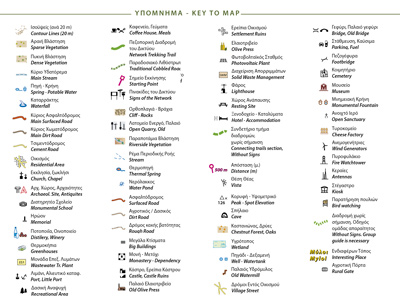- DISTANCE: klm
- DISTANCE RUNTIME:
- ALTITUDE (min): (max):
- ALTITUDE DIFFERENCE: m
- AREA MORPHOLOGY:
- ROUTE VEGETATION:
- MONUMENTS OF HISTORY AND CULTURE:
- CONNECTIONS WITH OTHER ROUTES OF THE NETWORK:
- ΠΡΟΣΒΑΣΕΙΣ και ΔΙΕΥΚΟΛΥΝΣΕΙΣ:
The Trekking Trails for use by locals and visitors are designed by studying the most noteworthy parts of the countryside of Lesvos and by applying strict criteria.
Making the most of the inexhaustible lattice of paths of Lesvos, what ends up to be offered as a ‘Trekking Trail’ stands out for being true to the reason it was created for: Safe trekking every season of the year and readily available relevant information that goes over the main points of the civilisation and natural environment of the island.
A Trail is something quite different to a simple path. The existing path with its timeless value in the region may be the base, but the term ‘Trail’ includes the care with which the best course was selected, which might move along parts of existing paths, leading with safety and easy access to places of interest, either historical or of particular natural beauty. Each Trekking Trail is mapped in detail so as to make available through many media all the information necessary to the trekker. To make following the Trail easy, there is regular cleaning of obstructive vegetation as well as repairs on the ground, dirt of cobblestone. The signs all along provide trekkers the assurance that they are on the right track while the big signs point to each monument of nature and civilisation, contributing, along with the information provided, in a full and in-depth familiarisation with the area.
These first Trekking Trail were created on the island based on this methodology and they make up the ‘Trekking Trails Network of Lesvos’.
Two categories of Trails, Circular and Traverse (normal routes), cleaned and sign-posted, offer safety and keep trekkers informed about the best ways to entertain, exercise and discover the island. At the same time the trekker has the option to choose a real-life on-the-spot experience by selecting freely his own route from the sign-posted Network of 222 kilometres.
Sign-posting within the Network is uniform, along with the printed material and all displayed information (signs, leaflets, internet), as part of the trekking aid.





